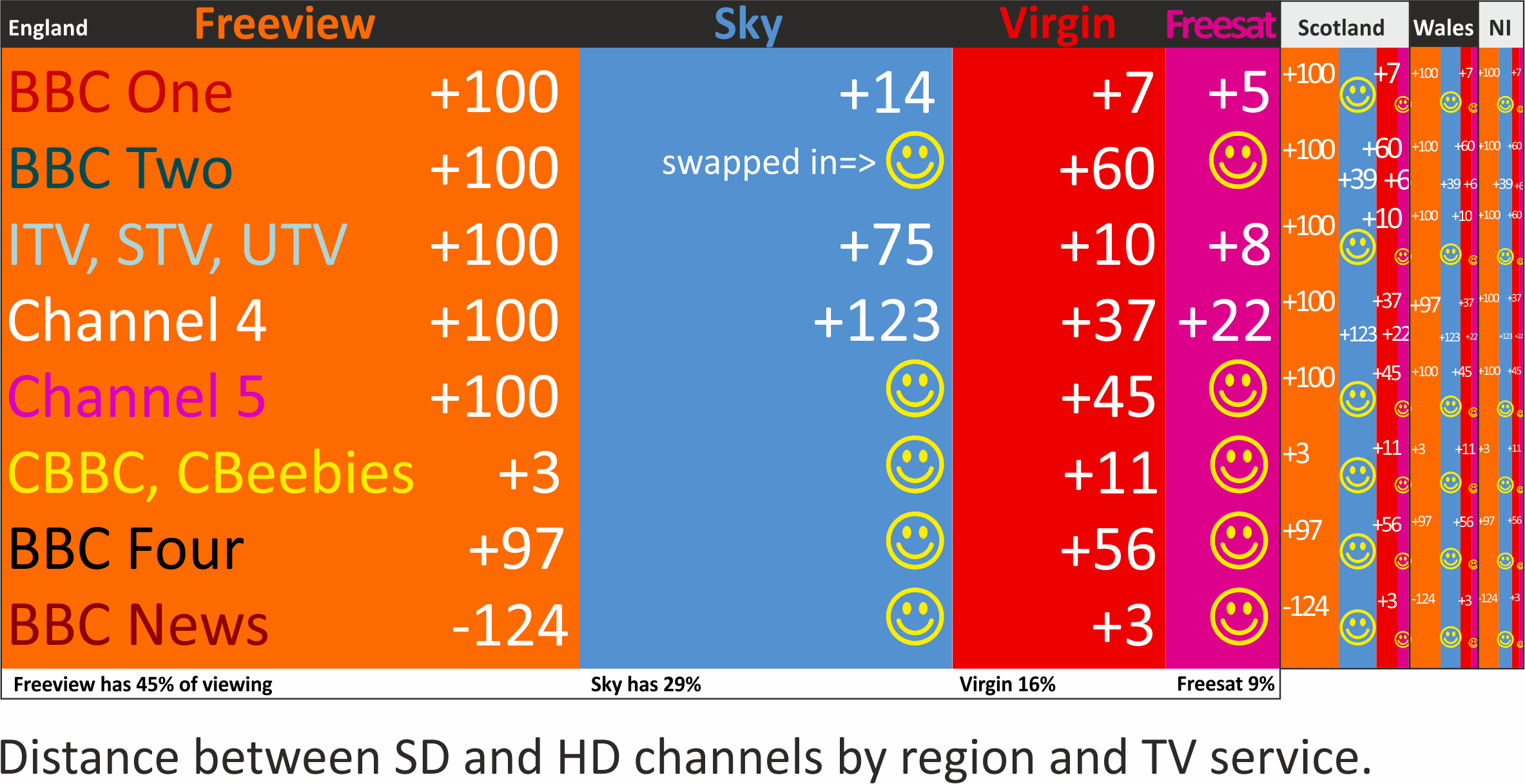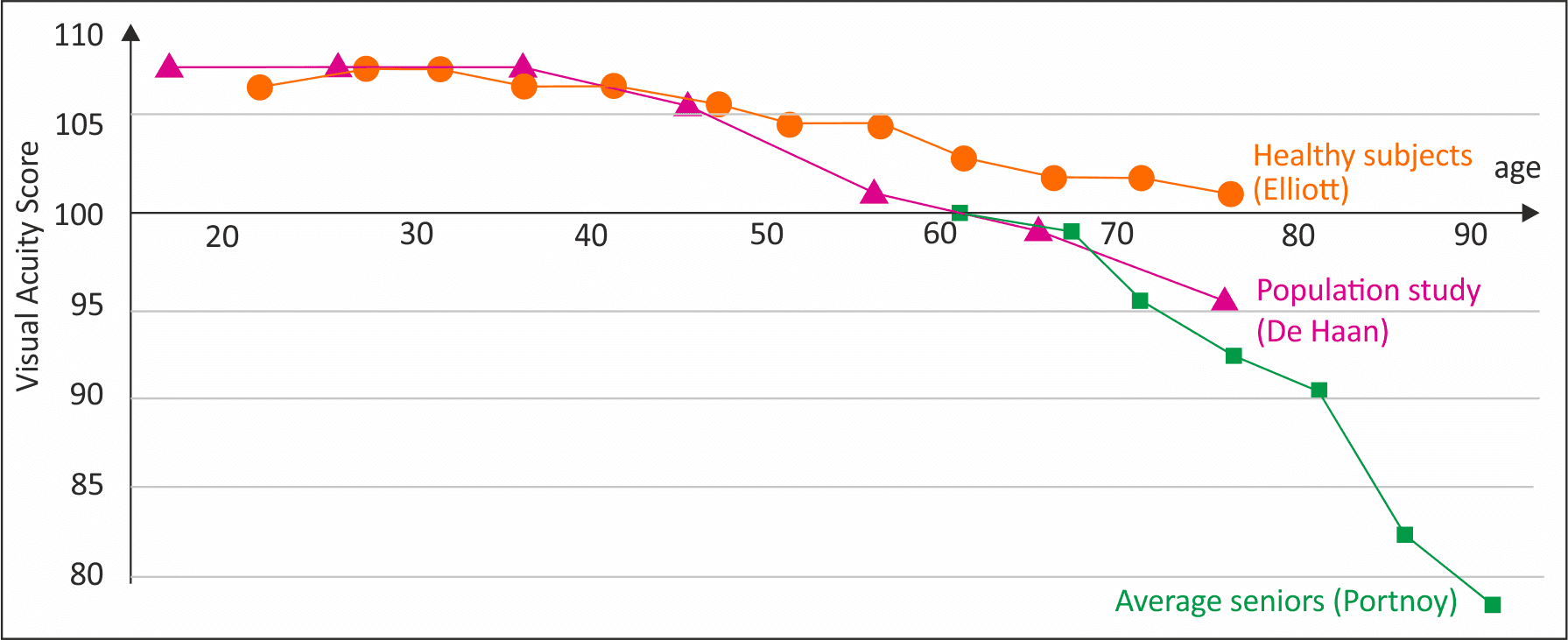Why do less than one in five people with an HD set watch in HD?

I have given some thought and I’ve come up with four main reasons:
- Not everyone has a HD receiver;
- It’s hard to find the channels in the programme guide;
- Not all shows look that much better in HD
- Eyesight is less good at the age where people watch lots of television
What do you think?
Reason 1: Not everyone has an HD receiver.
UK TV first started receiving Sky HD broadcasts in May 2006, Freesat HD in 2008 and finally Freeview HD in 2010. The digital switchover brought free HD to all homes in the UK by the end of October 2012.
However, for several years, HD television sets had the words “HD ready” on them. This means that the sets required an additional set-top box to get Freeview HD. Or, they could use a Sky+ HD subscription box or Freesat HD receiver.
That’s why in 2017, 77% of homes have an HD “ready” TV set as their main screen [1], but only 82% of those sets can watch a live HD service. [3]
Reason 2: It is a pain to find HD content as they are far away in the EPG
For the people who have the equipment to be able to watch in HD, it can still be very difficult to find the channels broadcast in HD.
Basically, this means you can’t surf the channel guide without making a very special effort to use the HD channels.
The logical place to find an HD channel would be as in place replacement, but only the HD satellite services do these simple swaps. So, the upshot is that even with the satellite swaps STILL only a third of BBC Two viewers watch in HD!
This diagram illustrates the logic of HD channel numbers by showing their numeric distance to move from normal, standard definition (SD) to HD.

How do we know this is an issue for lots of viewers?
However, what is very interesting is that the share of viewers using the HD services for viewing the main free-to-air, public service channels (which get 51% of total viewing) is [5]:
Why are the figures so low? It’s because on all Freeview sets, the HD channel numbers are not swapped with the single figures everyone knows, so you must know to add 100, 96, 97, 3 or even minus 124 to get the same PSB channel in HD.
It’s a little better on Sky HD and Freesat HD where you get in-place HD swaps for Channel 5 and in England BBC Two HD, outside England BBC One HD and STV or UTV. And you don’t need to hunt for the other HD BBC channels: CBBC, CBeebies and the news channel.
Will this problem ever be fixed?
Perhaps in hindsight it should have been the law for HD channels to be swapped into the EPG in the right place and for the broadcasters to provide regional news and adverts in HD for everyone?
There are good technical and money reasons for this: the regional news on BBC One costs a fortune to provide but there’s no budget to broadcast them all in HD on satellite; Channel 4 and ITV are paid for by advertisers who paid for the regionalization of adverts.
This situation may improve when Freeview eventually becomes a “HD first” service, which might be in 2022 perhaps?
So, making the total for HD viewing for these “big five” grow from 12% 2014 to 17% in 2016. If you draw a line, it would make current final changeover date to all-HD … 2099.
Reason 2b: And your TV salesman isn’t going to explain this to you…
Understandably, TV sellers want to show their merchandise at its very best. And the best way to do this is by showing specially made, extremely high-quality videos. Not by showing reruns of East Enders. That means you don’t get to see how to set up HD channels when you get the TV home. And it would be a very dedicated salesman who had the time to show you.
Have a visit to your local TV store and you’ll see this in practice. This week I checked out my local Curry’s PC World. Curry’s was using their old favourite of blockbuster 3D animated movies, which always look good on any screen.

Reason 3: Not all shows look that much better in HD
If you have a relatively new TV, you probably won’t be too bothered about finding those HD channels. Your favourite shows will look just great even on the normal channels.
There are TV programme genres that do really benefit from being watched in HD, especially nature documentaries and live stadium sport. But a lot of what people watch is news, soap operas and quiz shows. While these shows will look better in HD, the difference isn’t that great on modern TV sets.
Reason 3b: Shows made before 2009 were never made in HD
And you’re probably still watching a lot of reruns that were never made in HD anyway.
TV channels that show archive programmes (Drama, E4, Dave, ITV 3) or US imports (Pick, 5 USA) are incredibly popular among UK viewers. And these shows won’t have been produced in HD if they were made before 2009.
Reason 4: Eyesight is less good at the age where people watch lots of television
Forgive me for pointing this out, but for many of us we just can’t see the benefit of HD television. If, like me, you’re getting near middle aged, you’ll know all too well that eyesight declines with age. This is shown here on this chart.

And, its mostly people over 65 who watch a great deal of broadcast TV. Younger viewers prefer to use streaming services (Netflix, YouTube, etc.). And this trend is growing. [4]
Isn’t it ironic that the people who are watching the most broadcast TV get the least benefit from HD?

[1] https://www.statista.com/statistics/387729/market-share-of-hdtv-and-hd-ready-tv-sets-in-the-uk/
[2] http://www.digitaluk.co.uk/__data/assets/pdf_file/0007/92761/Digital_UK_Update_2017_online.pdf
[3] https://www.ofcom.org.uk/__data/assets/pdf_file/0016/105442/uk-television-audio-visual.pdf page 79
[5] https://www.ofcom.org.uk/__data/assets/pdf_file/0040/95899/CN16-08.pdf page 78
| Whenever i watch moving sport especially football I experience much poorer pictu | 1 |
6:10 PM
As an ex TV and video engineer with over 40 years in the electronics and computer industry since 1975, I was interested in this subject of why only a small percentage of people watch Freeview in HD when they have an HD receiver.
One of the biggest problems is the ever changing channel positions on the multiplexes, in addition to the fact HD channels numbers do not relate to the established number arrangements like the old analogue TV of the past did when we had our five basic channels arranged as 1,2 3,4 and 5.
Now I have to keep swapping 101 for 1 and 102 for 2 etc for the BBC only to find that regional BBC in the Midlands is still not covered by the HD service, heaven knows why even after seven years since the digital switch over. Then I have to go search for the BBC1 SD channel number to watch Midlands Today. The EPG is a very messy system with stations scattered all over the place and in no sensible grouping order. Also, not all TV's allow you to re-arrange the channels and keep them arranged in the order you want and in the end they all get reset out of order yet again after a re-tune!
| link to this comment |
Jeff Egginton: Definitely agree that tv channels are a bit of a jumbled up mess on electronic programme guides! Surely, the easiest way to combat the issue is for viewers to set up their favourites list of HD channels, including their respective regional output channels in SD, for ease of access?
I live in Border TV country within Scotland with two ITV Border channels. The Carlisle based channel is in HD, while its secondary service is based, north of the border in SD only. The main purpose of the secondary service is relay output for Scottish themed political programmes! Getting to the point, creating my favourites list has the two Border TV versions featured on the same page for easy access!
| link to this comment |
